Scottish Health Survey 2017 - volume one: main report
Presents results for the Scottish Health Survey 2017, providing information on the health and factors relating to health of people living in Scotland.
1. General Health, Long-Term Conditions and Cardiovascular Conditions
Qingyang Feng
Summary

- In 2017, the proportion of adults reporting being in ‘good’ or ‘very good’ health decreased with age from 86% of those aged 16-24 to 52% of those aged 75 and over.
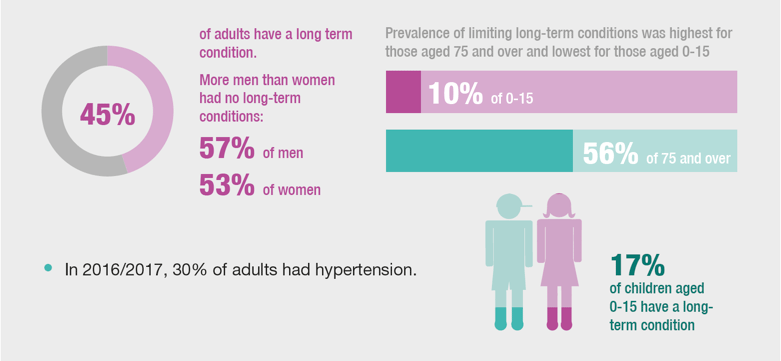

- Those living in less deprived areas were more likely to have attended CPR training than those in more deprived areas.
- Attendance levels were higher among those living in the three least deprived areas (57-60%) than among those in the 2nd most deprived and most deprived areas (50% and 46% respectively).

- In 2017, the most common reason for attending CPR training among those aged 16-24 was that it was part of their school/college/university work (43%).
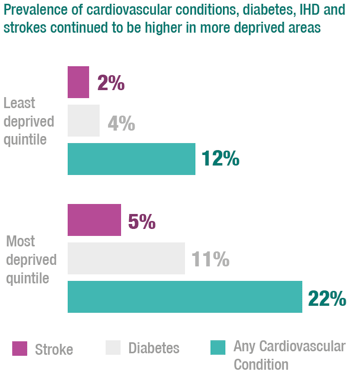
- In 2017 15% of adults had any CVD, 6% had doctor diagnosed diabetes, 19% had any CVD or diabetes, 5% had IHD, 3% had had a stroke and 7% had had a stroke or IHD, with no significant change since 2016.
1.1 Introduction
This chapter covers the following interrelated topics: self-assessed general health, long-term conditions, cardiovascular disease and Cardiopulmonary Resuscitation (CPR) training.
Population measures of self-reported health can be a general indicator of the burden of disease on society. They can reflect subjective experiences of both diagnosed and undiagnosed illnesses, and their severity, which more objective measures for the whole population can sometimes overlook.
Self-assessed general health is often a reflection of the presence or absence of long-term conditions, both physical and mental. In Scotland today people are living longer but with multiple long-term conditions and increasingly complex needs[1]. Such conditions account for 80% of all GP consultations and for 60% of all deaths in Scotland. People with a long-term condition are twice as likely as those without to be admitted to hospital and stay in hospital disproportionately longer. Older people are more likely to have long-term conditions and often multiple conditions. The proportion of the Scottish population aged 75 and over is projected to increase by 27% over the next ten years and by 79%, over the next 25 years[4]. Given Scotland's ageing population, long-term and multiple conditions have become an increasingly important public health issue.
Cardiovascular disease (CVD) is a general term describing diseases of the heart and blood vessels whereby blood flow to the heart, brain or body is restricted. It is one of the leading contributors to the global disease burden[5]. Its main components are ischaemic heart disease (IHD, or coronary heart disease) and stroke, both of which have been identified as clinical priorities for the NHS in Scotland[6],[7] Diseases of the circulatory system are the second most common cause of death in Scotland after cancer, accounting for 26% of deaths in 2017 (compared with 29% for cancer). This includes 12% of deaths which are caused by IHD, with a further 7% caused by cerebrovascular disease (e.g. stroke)[8]. Early mortality from heart disease and stroke have both improved in recent years, but concern remains about continuing inequalities in relation to morbidity and mortality linked to these conditions[2],[3].
Diabetes, the most common metabolic disorder, is a major health issue for Scotland; its prevalence having increased in recent years for a number of reasons including an ageing population, better survival rates, better detection rates for Type 2 diabetes and a steady increase in the incidence of Type 1 diabetes in Scottish children[9]. The UK has one of the highest levels of Type 1 diabetes in Europe, but it is the increasing prevalence of Type 2 diabetes – linked to obesity, physical inactivity and ageing – which is driving the overall increase in the condition and causing concern[10]. Diabetes is a risk factor in premature mortality, although more effective treatments for diabetes have offset some of the excess risk in recent years and mean some people may be living longer and better with the condition[7].
The associations of CVD conditions, diabetes and other long-term conditions with deprivation, lifestyle risk factors and wider health determinants are also of importance in Scotland given its persistent health inequalities[11],[12].
The prevalence of CVD, diabetes and other long term conditions therefore represents significant personal, social and economic costs both to individuals and their families as well as to health and care services and Scottish society more widely.
Cardiac arrest is when the heart suddenly stops pumping blood round the body. Cardiopulmonary Resuscitation (CPR) keeps blood circulating until attempts are made to restart the heart when someone has a cardiac arrest. Every year around 3,000 Scottish people have a cardiac arrest in the community and currently only 1 in 20 survive[13]. In areas of the world with the best survival rates almost a quarter people go home alive after cardiac arrest[14]. Prompt bystander CPR can increase the likelihood of survival by 2 or 3 times[15].
1.1.1 Policy background
The Scottish Government recognises the need to change the way services are delivered in the context of the changing Scottish demographic, notably the ageing population and the increasing number of people living with long term conditions and multi-morbidity. The strategic focus for improving general health and wellbeing and supporting people living with long term conditions is set-out in three over-arching strategies.
The National Clinical Strategy[16], published in 2016, is the high level vision for how health and social care services will develop over the next 10-15 years. The Health and Social Care Delivery Plan[17] sets out the programme to further enhance health and social care services so people can live longer, healthier lives at home or in a homely setting. These establish the overarching aims for public health concerned with prevention, early intervention and supported self-management. In Realising Realistic Medicine[18], published in 2017, the Government sets out plans to adopt Realistic Medicine, moving away from a culture where 'doctor knows best' to one where people receiving care are at the centre of decision-making and professionals are encouraged to take a personalised approach to their care. It aims to reduce harm and waste, tackle unwarranted variation in care, manage clinical risk, and support innovation to improve care and sustainability in the NHS.
One of the Scottish Government's new key National Performance Framework National Outcomes is that 'we are healthy and active[19]. This is supported by a number of National Indicators. There is a National Performance indicator for premature mortality (deaths from all causes in those aged under 75)[19]. CVD is described as one of the key 'big killer' diseases around which action must be taken if this target is to be met. In addition, a number of the National Indicators are linked to CVD risk factors, most notably smoking, but also physical activity and healthy weight[19](the latter two are also major risk factors for Type 2 diabetes). Due to the clinical priority given to heart disease and stroke by the Scottish Government, there has been some success in reducing death rates from these diseases in recent years[20].
The separate Heart Disease[21], Stroke[22], and Diabetes[23] Improvement Plans, published in 2014, align with the approaches set out in the Scottish Government's first overarching strategy for long-term conditions published in 2009. They reaffirm the aims and priorities on improved prevention, treatment and care in heart disease, stroke and diabetes, focusing on clinical outcomes and patient experience. Diabetes is known to increase the risk of CVD and the Diabetes Improvement Plan[23] focusses priority action to improve glycaemic control to reduce risk of associated complications and additionally to identify risk of complications early ensuring prompt treatment.
In March 2015, Scotland's Out-of-Hospital Cardiac Arrest (OHCA) Strategy was launched[24]. Its overarching aim is for Scotland to become an international leader in OHCA outcomes by 2020. This is underpinned by two high level aims:
- To increase survival rates after an OHCA to save 1,000 additional lives by 2020.
- To equip an additional 500,000 people in Scotland with CPR skills by 2020.
1.1.2 Reporting on general health, long-term conditions, CVD conditions and diabetes in the Scottish Health Survey
Valuable information on self-reported general health, prevalence of CVD conditions and diabetes in Scotland is provided by SHeS. This chapter reports on self-assessed general health and prevalence of long-term conditions by age and sex for adults and children in 2017. It also updates the trends in self-reported health and long-term conditions.
The Scottish Health Survey provides useful information on the prevalence of cardiovascular conditions across different population groups. In this chapter, trends in self-reported CVD conditions and diabetes prevalence by deprivation for adults are presented between 2003 and 2017. Self-reported CVD conditions and diabetes are also reported for 2017 by age and sex. Trends in adult hypertension are updated for 2017 and trends in adult hypertension by deprivation are presented. Additionally, the extent of diagnosis, treatment and control of hypertension are also explored. The prevalence of CPR training and training type for adults are explored by age, sex and deprivation.
The area deprivation data are presented in Scottish Index of Multiple Deprivation (SIMD) quintiles. To ensure that the comparisons presented are not confounded by the different age profiles of the quintiles, the data have been age-standardised. Readers should refer to the Glossary at the end of this Volume for a detailed description of both SIMD and age-standardisation.
Supplementary tables on general health and CVD are also published on the Scottish Health Survey website[25].
1.2 Methods and Definitions
1.2.1 Methods
Self-assessed general health
Each year, participants who are aged 13 and over, are asked to rate their health in general, with answer options ranging from 'very good' to 'very bad'. For children under the age of 13 the question is answered by the parent or guardian completing the interview on their behalf. The data for children (aged 0-15) is used in the calculation of healthy life expectancy used to monitor the related National Performance Framework indicator to improve healthy life expectancy.
Long-term conditions
All participants were asked if they had any physical or mental health condition or illness lasting - or likely to last - for twelve months or more. Those who reported having such a condition were asked to provide details of the type(s) of conditions or illnesses reported. Answers were recorded verbatim and then coded by an analyst. These questions did not specify that conditions had to be doctor-diagnosed; responses were thus based on individuals' perceptions.
At a later stage of the interview, participants were asked about a number of specific health conditions, including diabetes and hypertension. If the participant mentioned that they had doctor-diagnosed diabetes or that they had doctor-diagnosed hypertension in response to these questions, but they had not mentioned them as a long-term condition, they were each counted as such a condition.
CVD conditions and diabetes
Participants were asked whether they had ever suffered from any of the following conditions: diabetes, angina, heart attack, stroke, heart murmur, irregular heart rhythm, or 'other heart trouble'. If they responded affirmatively to any of these conditions, participants were asked whether they had ever been told they had the condition by a doctor and whether they had experienced the conditions in the previous 12 months. For the purposes of the analysis presented in this chapter, participants were only classified as having a particular condition if they reported that the diagnosis had been confirmed by a doctor.
It is important to note that no attempt was made to verify these self-reported diagnoses objectively. It is therefore possible that some misclassification may have occurred because some participants may not have remembered (or not remembered correctly, or not known about) diagnoses made by their doctor.
Blood pressure
Blood pressure was measured as part of the biological module[26], using the Omron HEM device. This equipment has been used on SHeS since 2003. Prior to 2012, blood pressure was collected in a follow-up interview conducted by survey nurses. The nurse interview was discontinued in 2012, and since then specially trained interviewers have been collecting some of the less complex measures and samples previously collected by nurses, as part of the biological module. The equipment and protocol for taking blood pressure readings did not change. A validation study was carried out to assess the impact of the switch from nurse to interviewer administration[27].
As a result, unadjusted measurements collected by interviewers are used within the report for more recent periods (2012/2013, 2014/2015 and 2016/2017), with calibrated estimates (nurse equivalent) being used to show longer-term trends.
Three blood pressure readings were taken from consenting participants at one minute intervals using an appropriately sized cuff and on the right arm where possible. Participants were in a seated position and readings were taken after a five minute rest. Systolic and diastolic pressures and pulse measurements were displayed on the Omron for each measure. As in previous years, pregnant participants were excluded.
Since the size of the cuff used when taking blood pressure readings is an important factor in ensuring that accurate measurements are obtained three different sizes of cuff were available for use. Full details of the protocol used to take blood pressure reading in the survey are available on request from ScotCen.
The blood pressure measures used in this chapter are the means of the second and third measurements obtained for those for whom three readings were successfully obtained. Analyses exclude results from participants who had eaten, drunk alcohol, smoked or exercised in the 30 minutes before the measurement was taken.
CPR training
Participants were asked whether they had ever had any type of training in CPR or learned CPR either through instructor led sessions or self-instruction using DVD/online instruction. Those who reported they had CPR training were asked to provide details of the time interval since the first training, whether they had attended refresher training and the type of CPR training.
1.2.2 Definitions
Any CVD condition
Participants were classified as having 'any CVD' if they reported ever having any of the following conditions confirmed by a doctor: angina, heart attack, stroke, heart murmur, abnormal heart rhythm, or 'other heart trouble'[28].
Diabetes
Participants were classified as having diabetes if they reported a confirmed doctor diagnosis. Women whose diabetes occurred only during pregnancy were excluded from the classification. No distinction was made between Type 1 and Type 2 diabetes in the interview.
Any CVD condition or diabetes
A summary measure of the above conditions is presented in the tables as 'any CVD condition or diabetes'.
Ischaemic heart disease (IHD)
Participants were classified as having IHD if they reported ever having angina or a heart attack confirmed by a doctor. All tables refer to ever having had the condition.
Stroke
Participants were classified as having a stroke if they reported ever having had a stroke confirmed by a doctor.
IHD or stroke
A summary measure of the above conditions is presented in the tables as 'IHD or stroke'.
Blood pressure levels classification
In accordance with guidelines on hypertension management[29] the threshold of 140/90mmHg is used to define hypertension in SHeS.
Adult participants were classified into one of four groups listed below on the basis of their systolic (SBP) and diastolic (DBP) readings and their current use of anti-hypertensive medications. For the purpose of this report, the term 'hypertensive' is applied to those in the last three categories.
Normotensive untreated |
SBP below 140mmHg and DBP below 90mmHg, not currently taking medication specifically prescribed to treat high blood pressure |
Hypertensive controlled |
SBP below 140mmHg and DBP below 90mmHg, currently taking medication specifically prescribed to treat high their blood pressure |
Hypertensive uncontrolled |
SBP at least 140mmHg or DBP at least 90mmHg, currently taking medication specifically prescribed to treat their high blood pressure |
Hypertensive untreated |
SBP at least 140mmHg or DBP at least 90mmHg, not currently taking a drug specifically prescribed to treat their high blood pressure |
Detection, treatment and control of hypertension
In addition to the objective definition of hypertension described above, participants were defined as having self-reported doctor-diagnosed hypertension if they stated during the interview that they had been told by a doctor or nurse that they had high blood pressure.
Hypertension detection was estimated by examining the proportion of those with survey defined hypertension (SBP at least 140mmHg or DBP at least 90 mmHg or on treatment for hypertension) reporting doctor-diagnosed hypertension. Treatment rates were estimated by examining the proportion of all those defined as having survey-defined hypertension who were on treatment at the time of the survey. The control of hypertension among those on treatment for hypertension at the time of the survey was estimated by calculating the proportion with blood pressure below 140/90mmHg.
When interpreting results it should be borne in mind that although three blood pressure readings were taken, these were all on a single occasion. Clinical diagnoses of hypertension are based on sustained levels of high blood pressure rather than a single measurement.1.3 Self-Assessed General Health
1.3.1 Trends in self-assessed general health since 2008
From a peak of 77% in 2009, the level of self-assessed 'good' or 'very good' health for adults dropped significantly to 74% in 2012 and has continued to be within the range of 73-74% since (73% in 2017). The level of self-assessed 'bad' or 'very bad' health fluctuated between 7% and 9% since 2008 (8% in 2017). Patterns were similar for men and women.
The overall proportions of children reporting 'good' or 'very good' health since 2008 had varied between 94% and 96%, remaining stable at 94% in 2017. Similarly, the proportion of children reporting 'bad' or 'very bad' health continued to be low (1%), consistent with the levels since 2008 (0-1%). The proportion of girls reporting 'good' or 'very good' health decreased significantly from 96% in 2016 to 93% in 2017, while the proportion of girls reporting 'bad' or 'very bad' health remained unchanged at 1%. Boys have had consistent levels of self-assessed general health since 2008. Table 1.1
1.3.2 Self-assessed general health among adults in 2017, by age and sex
In 2017, nearly three quarters (73%) of adults aged 16 and over described their general health as 'good' or 'very good'; meanwhile, one in twelve (8%) adults reported having 'bad' or 'very bad' health. Men and women's self-assessed general health did not differ significantly.
Consistent with previous SHeS reports[30], self-assessed general health was significantly associated with age among adults in 2017. The proportion of adults self-assessing their health as 'good' or 'very good' decreased with age from 86% among those aged 16-24 to 52% among those aged 75 and over. Correspondingly, the proportion of self-assessed 'bad' or 'very bad' health increased significantly from 2% among the youngest age group (16-24) to 15% among the oldest age group (75 and over). Similar patterns were found for men and women.
Figure 1A, Table 1.2
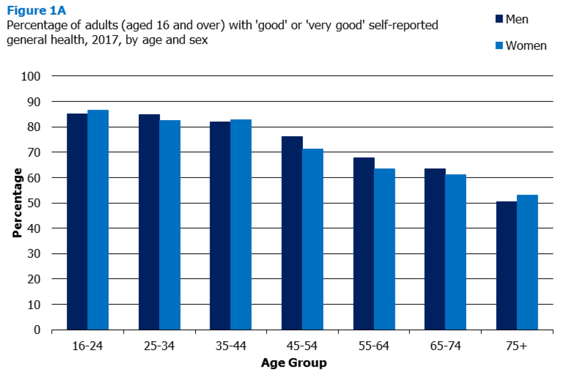
1.4 Long-Term Conditions
1.4.1 Trends in long-term conditions since 2008
The proportion of adults aged 16 and over reporting long-term conditions increased significantly between 2008 and 2012 from 41% to 46%; the level has remained stable since then (44-47%). The proportion of adults reporting limiting long-term conditions followed the same trend as the overall prevalence of long-term conditions (23% in 2008 and 28% in 2012 for men; 28% in 2008 and 35% in 2012 for women), and remained stable thereafter.
The proportion of children with long-term conditions increased significantly between 2008 (14%) and 2014 (19%). After the peak in 2014, the level significantly decreased to 15% in 2015 and has remained stable since then (15%-17%). The proportion of girls reporting limiting long-term conditions increased significantly from 6% in 2016 to 10% in 2017. Figure 1B, Table 1.3
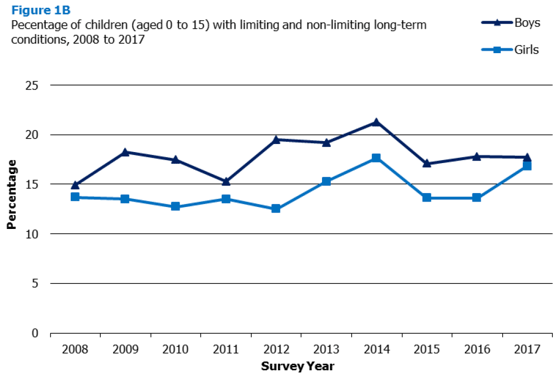
1.4.2 Prevalence of long-term conditions in 2017, by age and sex
In 2017, the long-term condition prevalence was 45% among all adults aged 16 and over and 17% among children aged 0-15. Around a third (32%) of adults reported living with limiting long-term conditions whereas 13% reported living with non-limiting long-term conditions. The proportions of children that reported living with limiting and non-limiting conditions were 10% and 7% respectively.
The proportion of men (57%) free of long-term conditions in 2017 was significantly higher than women (53%). This is attributable to the significantly higher prevalence of limiting long-term conditions among women (34%) than men (29%), especially among those aged 35-44 (17% among men and 24% among women) and 45-54 (23% among men and 33% among women). In contrast with findings from previous SHeS reports where prevalence has generally been higher for boys[31], the prevalence of long-term conditions did not vary significantly between boys and girls in 2017 (both 17%).
The prevalence of long-term conditions for adults in 2017 varied significantly by age. Older adults were more likely than younger adults to report non-limiting long-term conditions (between 7% and 10% among those aged under 45 compared with between 16% and 20% among those aged 45 and over). Similarly, the prevalence of limiting conditions was 17-28% for those aged 16-54 and 40-56% for those aged 55 and over.
Distinct from previous SHeS reports[32], in 2017 the 16-24 age group (26%) had significantly higher prevalence of limiting long-term conditions than those aged 25-34 (17.2%). Figure 1C, Table 1.4
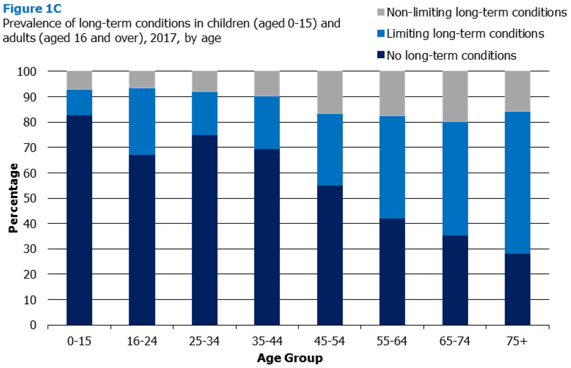
1.5 Cardiovascular Conditions and Diabetes
1.5.1 CVD and diabetes, 2017, by age and sex
Any CVD
In 2017, 15% of all adults (16% of men and 15% of women) reported having a CVD condition.
In 2017 the prevalence of CVD conditions was significantly associated with age with stepped increases across the age groups from 5% among those aged 16-24 to 43% among those aged 75 and over.
Doctor-diagnosed diabetes
The prevalence of adults reporting doctor-diagnosed diabetes was 6% in 2017 (7% for men and 6% for women). Prevalence increased markedly with age from 1% of those aged 16-34 to 16% of those aged 75 and over.
Any CVD or diabetes
In 2017, around one in five adults (19%; 21% of men and 18% of women) reported having CVD conditions or doctor-diagnosed diabetes. The prevalence increased significantly with age (with 51% of those aged 75 and over reporting CVD conditions or diabetes compared with 5% of those aged 16-24).
Among those aged 55 and over, a significantly higher proportion of men reported CVD conditions or doctor-diagnosed diabetes than women (29-57% for men compared with 22-48% for women).
IHD
In 2017, the overall proportion of adults reporting an IHD diagnosis was 5% (6% for men and 4% for women). The prevalence of IHD diagnosis increased significantly with age from none or a negligible proportion of adults aged 16-44 to 3% of adults aged 45-54 and then increased steadily with age to 21% of adults aged 75 and over.
Among the 45-64 and 75 and over age groups, the proportion of men reporting IHD diagnosis was significantly higher than women (5-9% compared to 1-4% respectively for those aged 45-64 and 27% compared to 16% respectively for those aged 75 and over). Although prevalence was also higher for men than women among those aged 65-74, the difference was not significant.
Stroke
The stroke prevalence was 3% for both men and women in 2017. The prevalence of stroke was significantly associated with age, with less than 1% prevalence among adults aged 16-34 compared with 9% among adults aged 75 and over.
The only significant difference in prevalence by age between men and women was among those aged 45-54; in this age group men were more likely than women to report having had a stroke (4% of men compared to 1% of women).
IHD or stroke
The combined prevalence of IHD or stroke diagnosis for all adults was 7% in 2017. Prevalence increased steadily with age from less than 1% of adults aged 16-34 to 27% of adults aged 75 and over.
The overall prevalence of IHD or stroke among women (6%) was significantly lower than among men (9%). Among the 45-64 and 75 and over age groups, the proportion of men reporting IHD diagnosis or stroke was significantly higher than women (7-13% compared to 2-8% respectively for those aged 45-64 and 33% compared to 23% respectively for those aged 75 and over). Although prevalence was also higher for men than women among those aged 65-74, the difference was not significant. Table 1.5
1.5.2 Trends in CVD and diabetes prevalence (age-standardised) since 2003, by area deprivation
Any CVD
In 2017, the highest age-standardised prevalence of adults reporting CVD was among those living in the most deprived areas (22% compared with 12% in the most deprived areas. This was similar for both men (25% compared with 12% respectively) and women (20% compared with 12% respectively); this has generally been the pattern since 2003.
The extent of inequalities in CVD prevalence by area deprivation has varied since 2003 but with no clear pattern; the gap in prevalence between the most and least deprived areas was lowest in 2008 and 2010 at 5 percentage points and highest in 2017 at 10 percentage points.
Doctor-diagnosed diabetes
The age-standardised prevalence of doctor-diagnosed diabetes varied significantly by deprivation quintile in 2017. Almost three times more adults in the most deprived quintile reported doctor-diagnosed diabetes than those in the least deprived quintile (11% compared with 4%). This pattern has been consistent since 2003. Similar patterns were found for both men and women.
The gap in prevalence for all adults between the most and least deprived quintiles was larger in 2017 (7 percentage points) than in previous survey years (3-5 percentage points).
IHD
The age-standardised prevalence of IHD was significantly associated with area deprivation. In 2017, three times as many adults reported IHD in the most deprived quintile than in the least deprived quintile (9% compared 3%). A similar pattern was found for men (10% compared to 5%) and for women (8% compared to 1%). This pattern has been consistent across previous survey years.
The gap in prevalence for all adults between the most and least deprived quintile was highest in 2003 and 2014 at 7 percentage points (6 percentage points in 2017).
Stroke
Similar to other cardiovascular conditions, the highest age-standardised prevalence of stroke was among adults living in the most deprived area quintile for all survey years since 2003. In 2017, the proportion of adults reporting stroke in the most deprived quintile (5%) was more than twice the proportion as those in the least deprived quintile (2%).
The gap in prevalence between the most and least deprived areas has fluctuated between 1 and 4 percentage points since 2003 (3% in 2017).
Figure 1D, Table 1.6
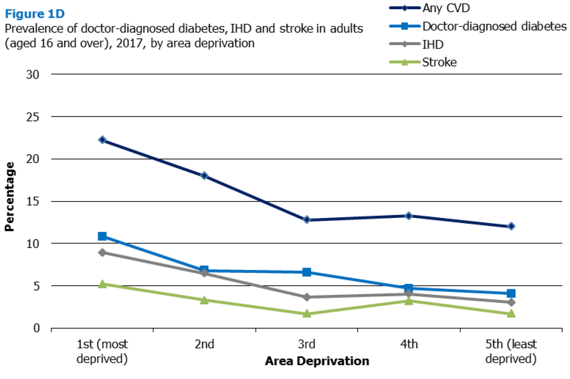
1.5.3 Trends in blood pressure level since 2003
To increase the sample size available the detailed analysis of blood pressure trends since 2003 used sets of two-years of combined data from 2008/2009.
Using the nurse-equivalent calibrated estimates, the combined data from 2016 and 2017 show that 30% of adults aged 16 and over had hypertension. As shown in Figure 1E, the nurse-equivalent calibrated estimates for all adults remained at a similar level to that in 2012/2013 (28%) following a significant decrease from 33% in 2010/2011. Similar patterns were found for men and women. Figure 1E, Table 1.7
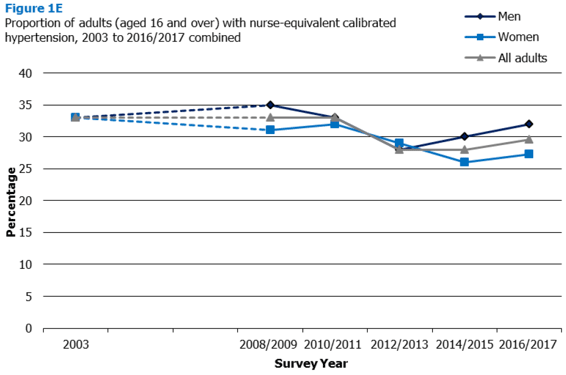
1.5.4 Trends in blood pressure level (age-standardised) since 2003, by area deprivation
Over the trend period significant differences among deprivation quintiles were only observed during 2010/2011 and 2016/2017. In 2010/2011, the highest age-standardised prevalence of hypertension was 40% among adults in the most deprived quintile, with prevalence ranging between 28-37% among the other quintiles. In 2016/2017, the age-standardised prevalence of hypertension in the two least deprived quintiles (23-24%) was around 10 percentage points lower than that of the other quintiles (32-34%). Patterns were similar for men and women.
1.5.5 Detection and treatment of hypertension among adults in 2014-2017 (combined), by age and sex
The hypertension detection rate in Table 1.9 shows the proportion of adults aged 16 and over with survey-defined hypertension who also reported doctor-diagnosed hypertension. In 2014-2017 combined, the hypertension detection level among all adults with survey-defined hypertension was 59%. Women had a significantly higher hypertension detection level (62%) than men (55%). The hypertension detection level increased significantly by age group, from 20% among people aged 16-24 to 71% among people age 75 and over. A similar pattern was found for men and women.
In 2014-2017 combined, 27% of adults with survey-defined hypertension had normal blood pressure under medication (hypertension treated and controlled), while 21% of adults with survey-defined hypertension were still having high blood pressure readings under medication (hypertension treated, but not controlled). The hypertension treatment level did not differ significantly between men and women, but it did vary significantly by age. The proportion of adults having high blood pressure readings under medication was significantly higher among the older age group (27-28% among those aged 65 and over) than that among the younger age group (10-19% among those aged 25-64). Table 1.9
1.6 CPR Training
1.6.1 CPR training history among adults in 2017, by age and sex
In 2017, more than half of adults (54%) reported having ever attended CPR training with no significant difference between men and women. The proportion of adults attending CPR training varied significantly by age with the highest among those aged 16-54 (60%-62%) and the lowest among those aged 75 and over (23%).
Among those that had ever had CPR training, the majority (69%) had their original training 5 years ago or more. The proportions of attendance within the past 12 months were patterned by age, decreasing from 16% among adults aged 16-24, to 4% for those aged 65-74 and none of the adults that took part in the survey aged 75 and over.
Overall, 40% of those who had ever attended CPR training also reported attending refresher training. The proportion of adults that had attended refresher training varied by age (42-48% among those aged 25-64 compared to 33% of those aged 16-24, 23% of those aged 65-74 and 14% of those aged 75 and over (see Figure 1F).
Among adults who had any CPR training (original or refresher), more than a third (36%) had the training within the past two years with younger adults more likely to do so than older adults (37-50% for those aged 16-54 compared with 6-29% for those aged 55 and over). The youngest age group had the highest proportion (50%) of any CPR training within the past two years; the oldest group had the lowest (6%).
In 2017, a fifth (20%) of all adults reported attending any CPR training (original or refresher) within the past two years; the highest level was among the youngest age group (30%) and the lowest was among the oldest group (1%). Figure 1F, Table 1.10
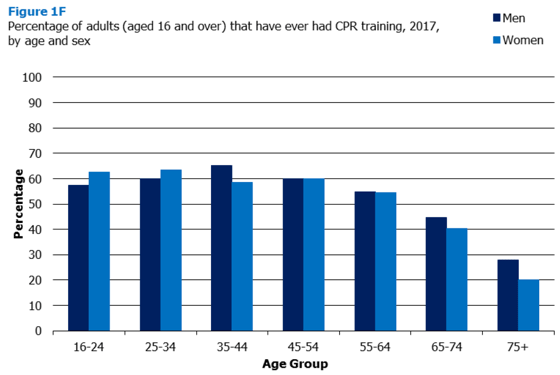
1.6.2 CPR training history among adults in 2017 (age-standardised), by area deprivation
In 2017, the prevalence of ever attending CPR training was significantly associated with area deprivation. The attendance level was higher among those living in the three least deprived areas (57-60%) than among those in the 2nd most deprived and most deprived areas (50% and 46% respectively). The pattern by deprivation was similar for men and women.
The length of time since original CPR training or attendance at refresher training did not differ significantly by area deprivation in 2017.
1.6.3 Type of CPR training last attended among adults in 2017, by age and sex
In 2017, of the adults who had ever attended CPR training, the most common type of training was as a compulsory part of their work (42%) or they had opted to take the training as part of work (23%). For 7%, CPR training was compulsory as part of voluntary work or a hobby and 9% opted to take it as part of voluntary work or a hobby. CPR training was taken by 12% of adults whilst they were a student as part of school / college / university work and 3% did so because they were a parent or carer. Only 1% of those that had attended CPR training taught themselves from a book, the internet or another self-learning tool.
Adults in the youngest age group were more likely than those in other age groups to undertake CPR training as part of their school/college or university work (43% among those aged 16-24 compared with 1-18% of other age groups). Those in the 16-24 age group and those aged 65 and over were more likely than other age groups to undertake CPR training as an option as part of their voluntary work or hobby (15%, 12% and 11% respectively compared with 5-9% for other age groups). Those aged 16-24 were less likely than those in older age groups to have attended CPR training as a compulsory part of their work (16% among those aged 16-24 compared to 43-51% among those aged 25 and over), they were also less likely than older age groups to have opted to do CPR training as part of their work (9% compared to 21-32% among those aged 25 and over). CPR training taken primarily on the basis of being a parent or carer was more common among women (4%) than men (1%). Table 1.12
Contact
There is a problem
Thanks for your feedback